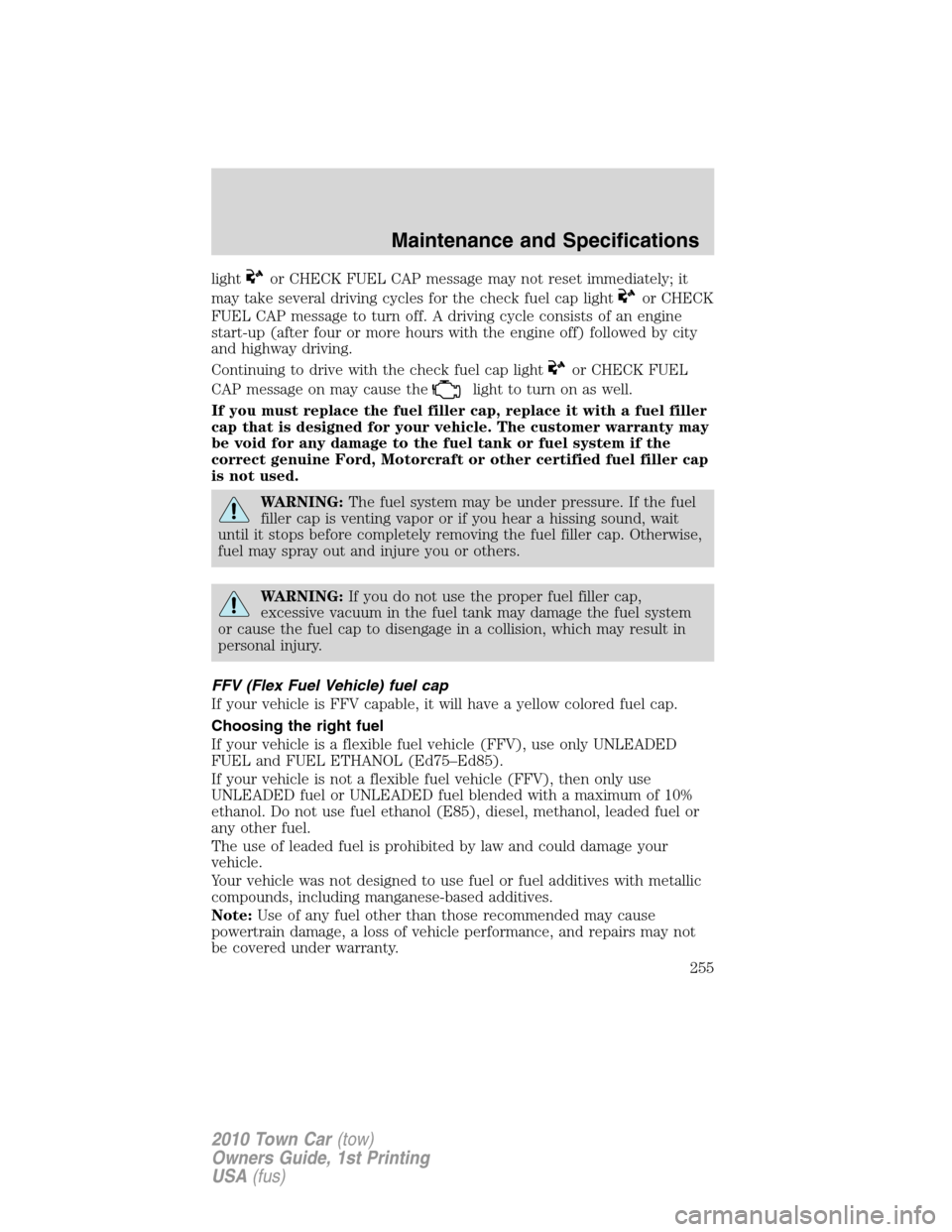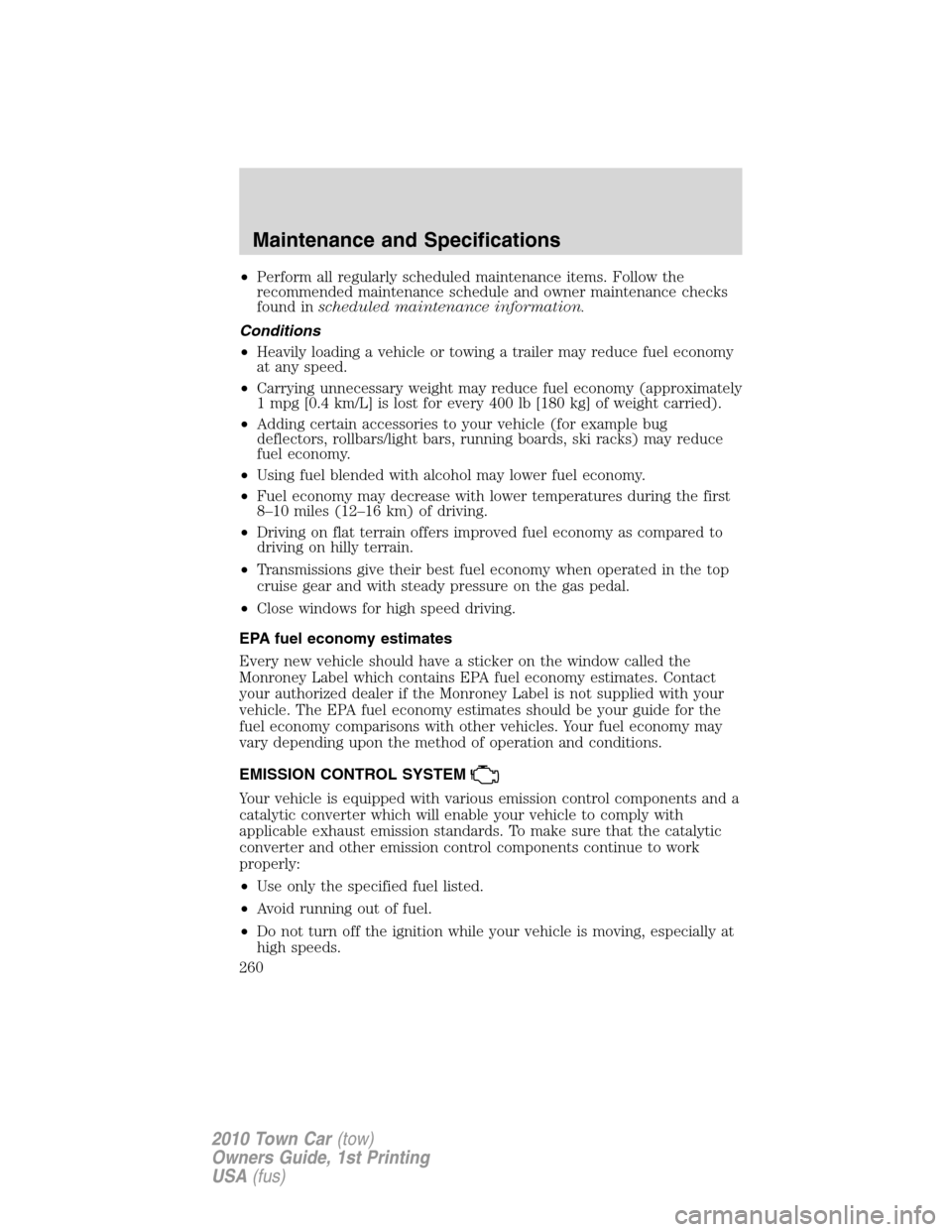Page 255 of 285

lightor CHECK FUEL CAP message may not reset immediately; it
may take several driving cycles for the check fuel cap light
or CHECK
FUEL CAP message to turn off. A driving cycle consists of an engine
start-up (after four or more hours with the engine off) followed by city
and highway driving.
Continuing to drive with the check fuel cap light
or CHECK FUEL
CAP message on may cause the
light to turn on as well.
If you must replace the fuel filler cap, replace it with a fuel filler
cap that is designed for your vehicle. The customer warranty may
be void for any damage to the fuel tank or fuel system if the
correct genuine Ford, Motorcraft or other certified fuel filler cap
is not used.
WARNING:The fuel system may be under pressure. If the fuel
filler cap is venting vapor or if you hear a hissing sound, wait
until it stops before completely removing the fuel filler cap. Otherwise,
fuel may spray out and injure you or others.
WARNING:If you do not use the proper fuel filler cap,
excessive vacuum in the fuel tank may damage the fuel system
or cause the fuel cap to disengage in a collision, which may result in
personal injury.
FFV (Flex Fuel Vehicle) fuel cap
If your vehicle is FFV capable, it will have a yellow colored fuel cap.
Choosing the right fuel
If your vehicle is a flexible fuel vehicle (FFV), use only UNLEADED
FUEL and FUEL ETHANOL (Ed75–Ed85).
If your vehicle is not a flexible fuel vehicle (FFV), then only use
UNLEADED fuel or UNLEADED fuel blended with a maximum of 10%
ethanol. Do not use fuel ethanol (E85), diesel, methanol, leaded fuel or
any other fuel.
The use of leaded fuel is prohibited by law and could damage your
vehicle.
Your vehicle was not designed to use fuel or fuel additives with metallic
compounds, including manganese-based additives.
Note:Use of any fuel other than those recommended may cause
powertrain damage, a loss of vehicle performance, and repairs may not
be covered under warranty.
Maintenance and Specifications
255
2010 Town Car(tow)
Owners Guide, 1st Printing
USA(fus)
Page 260 of 285

•Perform all regularly scheduled maintenance items. Follow the
recommended maintenance schedule and owner maintenance checks
found inscheduled maintenance information.
Conditions
•Heavily loading a vehicle or towing a trailer may reduce fuel economy
at any speed.
•Carrying unnecessary weight may reduce fuel economy (approximately
1 mpg [0.4 km/L] is lost for every 400 lb [180 kg] of weight carried).
•Adding certain accessories to your vehicle (for example bug
deflectors, rollbars/light bars, running boards, ski racks) may reduce
fuel economy.
•Using fuel blended with alcohol may lower fuel economy.
•Fuel economy may decrease with lower temperatures during the first
8–10 miles (12–16 km) of driving.
•Driving on flat terrain offers improved fuel economy as compared to
driving on hilly terrain.
•Transmissions give their best fuel economy when operated in the top
cruise gear and with steady pressure on the gas pedal.
•Close windows for high speed driving.
EPA fuel economy estimates
Every new vehicle should have a sticker on the window called the
Monroney Label which contains EPA fuel economy estimates. Contact
your authorized dealer if the Monroney Label is not supplied with your
vehicle. The EPA fuel economy estimates should be your guide for the
fuel economy comparisons with other vehicles. Your fuel economy may
vary depending upon the method of operation and conditions.
EMISSION CONTROL SYSTEM
Your vehicle is equipped with various emission control components and a
catalytic converter which will enable your vehicle to comply with
applicable exhaust emission standards. To make sure that the catalytic
converter and other emission control components continue to work
properly:
•Use only the specified fuel listed.
•Avoid running out of fuel.
•Do not turn off the ignition while your vehicle is moving, especially at
high speeds.
Maintenance and Specifications
260
2010 Town Car(tow)
Owners Guide, 1st Printing
USA(fus)
Page 284 of 285

Power trunk ..........................74, 76
Power Windows ...........................57
R
Radio ......................................26, 31
Rear window defroster ...............41
Recommendations for
attaching safety restraints for
children ......................................131
Relays ........................................199
Remote entry system .................81
illuminated entry ......................86
locking/unlocking doors ...........82
opening the trunk .....................83
panic alarm ...............................83
replacement/additional
transmitters ...............................85
replacing the batteries .............84
Reverse sensing system ...........193
Roadside assistance ..................197
S
Safety belts
(see Safety restraints) ....103, 106,
108–111
Safety Canopy ...........................126
Safety defects, reporting ..........228
Safety restraints ...............103, 106,
108–111
Belt-Minder�...........................112
extension assembly ................111
for adults .........................108–111
for children .............................129
lap belt ....................................108
Occupant Classification
Sensor ......................................104
warning light and chime ........112Safety restraints - LATCH
anchors ......................................138
Safety seats for children ..........133
Safety Compliance
Certification Label ....................273
Seats ............................................95
child safety seats ....................133
easy access/easyout
feature .....................................102
heated ......................................100
memory seat .....................84, 102
SecuriCode keyless entry
system ..........................................87
SecuriLock passive anti-theft
system ..........................................89
Servicing your vehicle ..............236
Spark plugs,
specifications .....................268, 272
Specification chart,
lubricants ...................................269
Speed control ..............................60
Starting a flex fuel vehicle .......181
Starting your vehicle ........179–181
jump starting ..........................215
Steering wheel
controls ......................................63
tilting .........................................54
T
Tilt steering wheel ......................54
Tire Pressure Monitoring
System (TPMS)
Tires, Wheels and Loading ....163
Tires ...........................148–149, 206
alignment ................................156
care ..........................................152
Index
284
2010 Town Car(tow)
Owners Guide, 1st Printing
USA(fus)